China, with its rich history and remarkable engineering achievements, is home to some of the most impressive water wheels in the world. These magnificent structures, which harness the power of flowing water, have played a vital role in Chinese civilization for centuries. In this article, we will explore the significance, design, and historical importance of water wheels in China.
what is water wheels?
A water wheel is a mechanical device that uses the force of flowing or falling water to generate power. It consists of a large wheel or a set of wheels with blades or buckets attached to its circumference. Water wheels have been used for centuries as a source of energy for various purposes, including grinding grain, sawing wood, and powering machinery.
The primary function of a water wheel is to convert the kinetic energy of water into rotational motion. The design and configuration of water wheels can vary, but the basic principle remains the same. When water flows or falls onto the wheel, the blades or buckets capture the water’s energy and cause the wheel to rotate. This rotational motion can be harnessed to perform mechanical work.
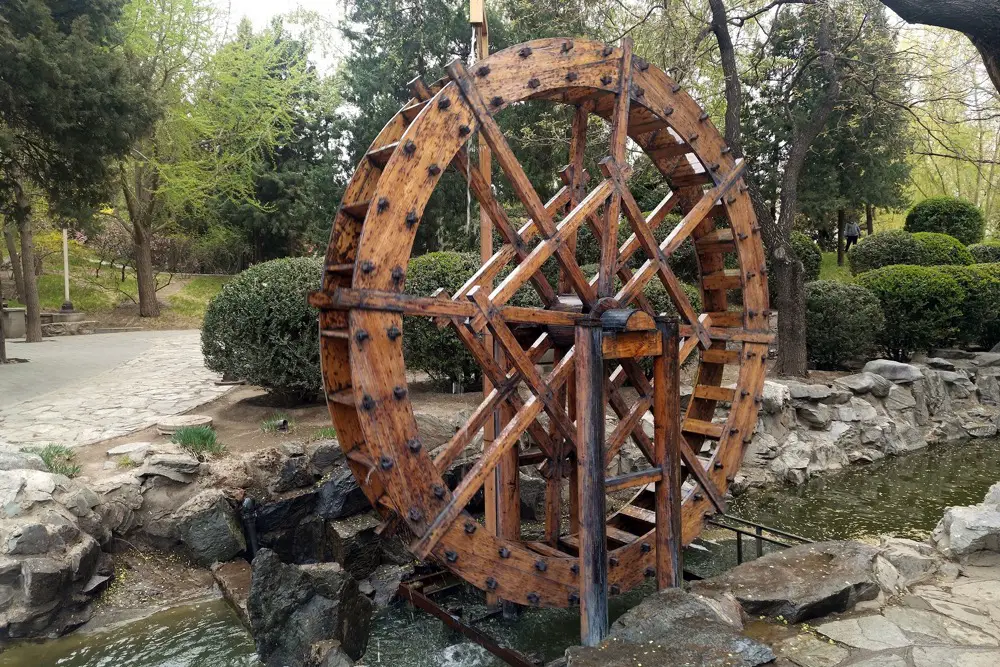
what is the purpose of a water wheel?
The purpose of a water wheel is to harness the energy of flowing or falling water and convert it into rotational motion. This rotational motion can then be used to perform various tasks and power different types of machinery. The primary functions and purposes of a water wheel are as follows:
Power Generation: Water wheels have historically been used as a source of mechanical power. They were used to drive machinery in industries such as milling, mining, and manufacturing. By converting the energy of flowing water into rotational motion, water wheels provided a reliable and renewable source of power.
Grinding Grains: One of the most common uses of water wheels was for grinding grains into flour. Mills equipped with water wheels utilized the rotational motion to turn millstones, which crushed and ground grains. This process was essential for food production and played a crucial role in ancient and medieval agriculture.
Sawing and Woodworking: Water wheels were employed in sawmills to power saw blades for cutting logs into lumber. The rotational motion of the water wheel was transferred to a vertical or horizontal saw, enabling efficient and precise cutting of wood. Water-powered sawmills played a significant role in the development of the timber industry.
Pumping Water: Water wheels were used to lift water for irrigation purposes. By attaching a system of gears and pumps to the water wheel, water could be lifted from lower levels to higher levels, allowing for efficient irrigation of fields and gardens.
Industrial Applications: Water wheels were utilized in various industrial processes, such as crushing ores in mining operations, operating bellows in iron smelting, and powering textile machinery in spinning and weaving mills. The rotational motion provided by water wheels facilitated the automation of these processes and increased productivity.
Cultural and Historical Significance: Beyond their functional purposes, water wheels hold cultural and historical significance. They are seen as iconic symbols of human ingenuity and the utilization of natural resources. Preserved water wheel sites often attract tourists and history enthusiasts who appreciate the engineering achievements and technological advancements of the past.
While water wheels have been largely replaced by more modern forms of energy generation, their historical importance and contributions to various industries cannot be overstated. They represent a time when harnessing the power of water was essential for human progress and the advancement of civilization.
what is the ancient Chinese water wheel?
The water wheel, also known as the “shuiche” “tianche,” “fanche,” “laohuche,” “longgu shuiche,” “tache,” “tongche,” and so on. is an ancient agricultural machinery that continuously extracts water from rivers, lakes, and other surface water sources. It is used for both water supply in higher areas and drainage in lower fields. Water wheels are widely employed in the irrigation of hilly terrains and terraced fields, enabling agricultural production to overcome the limitations of topography. They have made significant contributions to ancient Chinese agriculture.
The water wheel is an ancient tool for lifting water and irrigation. It is also known as the “tianche,” standing over 10 meters tall. It is supported by a 5-meter long axle with 24 wooden radial bars that radiate outwards. Each radial bar has a scraper and a water bucket at its top. The scraper scrapes the water, while the water bucket collects it. As the river water flows in, the radial bars slowly rotate due to the momentum of the water, gradually lifting the water buckets filled with river water. When reaching the top, the water buckets naturally tilt, pouring the water into the trough, which then flows into the irrigated farmland.
China has always been an agrarian society, and it has achieved remarkable scientific and technological advancements related to agriculture. As an essential part of agriculture, water management has received significant attention and investment from various dynasties. Large-scale irrigation channels and canals were constructed, mobilizing a considerable amount of manpower, resources, and financial investment. However, most of these channels were distributed in major agricultural regions, neglecting the higher areas or locations far from the irrigation channels and water sources. Therefore, the ingenious Chinese laborers invented a farming tool called the “shuiche” to enable water irrigation.
The water wheel closely resembles an ancient-style wagon wheel. The diameter of the wheel can be as large as 20 meters or more, with smaller ones exceeding 10 meters. It can lift water up to a height of 15-18 meters. The center of the wheel consists of a thick axle and a crossbeam that is twice the number of water buckets. A large water wheel can irrigate six to seven hundred mu (approximately 40-47 hectares) of farmland, while smaller ones can irrigate one to two hundred mu (approximately 6.7-13.3 hectares). Water wheels save labor, effort, and financial resources, making them the most advanced irrigation tool in ancient times.
The earliest water-lifting tool in Chinese folklore was called “jiegao” or “juji.” In the book “Zhuangzi – Outer Chapters – Heaven and Earth,” it is mentioned that when Zilu traveled south, he encountered an elderly man working hard to lift water with a bucket for irrigation. Zilu then introduced a labor-saving device called the “gao” to the old man. The gao was made by carving wood into a mechanism with a heavier back end and a lighter front end, allowing for efficient water lifting with less effort. From carrying water with a bucket to using the juji for preliminary mechanical water lifting, these inventions paved the way for the invention of water wheels.
Water wheels are widely used in the hilly regions of southwestern China and along the middle and upper reaches of the Yellow River in northwestern China. They can also be found in provinces such as Yunnan, Guangxi, Sichuan, Gansu, Shaanxi, and Guangdong. Of particular note is the fact that water wheels from the Tang Dynasty had been introduced to Japan. In 829 AD, the Japanese “Taijofu-fu” specifically mentioned the construction of water wheels, stating, “It is said that in the Tang Dynasty, they extensively used water wheels to overcome the inconvenience of canals and dykes. Even in areas with no natural water sources, they still achieved benefits through the use of water wheels. However, the people here are not accustomed to this technology and suffer from hardship. It is advisable to learn from the local population and produce tools and equipment for agricultural purposes. These can be operated by hand, foot, or even with the help of oxen, according to convenience.” This record not only provides excellent evidence of economic and cultural exchanges between China and Japan but also vividly illustrates that the use of water wheels had become a “Tang Dynasty trend,” with various types such as hand-operated, foot-operated, and ox-drawn.
However, with the development of technology, water wheels may have lost their practical value in many areas. Nevertheless, they still hold artistic and craftsmanship value as decorative pieces.
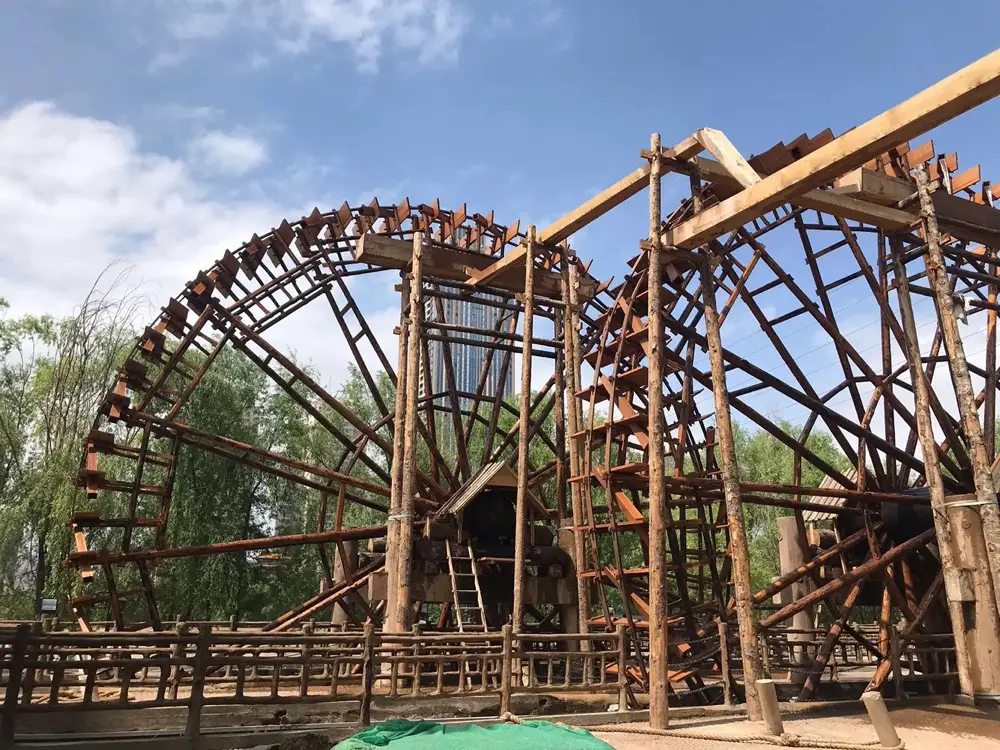
what is Chinese water wheels made of?
Ancient Chinese water wheels were primarily made of two materials: wood and bamboo, with bamboo leaves occasionally used as well. For example, the construction of the wooden components of a longgu water wheel required the selection of sturdy, decay-resistant, and crack-resistant trees such as elm, sandalwood, mulberry, and Chinese catalpa.
what is Chinese water wheels used for?
The water wheel is an agricultural machinery that continuously lifts water from surface water sources such as rivers, lakes, and ponds. It can both fetch water from higher areas and drain water from lower fields. It is widely used for irrigation in hilly regions and terraced fields, effectively overcoming the limitations of terrain in agricultural production and making significant contributions to ancient Chinese agriculture.
The functions of ancient water wheels are as follows:
Irrigation: They are used to irrigate fields and supply water to crops.
Power generation: By harnessing the flow of water, water wheels can generate mechanical power to operate devices such as millstones and bellows.
China has always been an agrarian society, and remarkable achievements have been made in agricultural-related scientific and technological advancements throughout its history. As water is an indispensable element in agriculture, successive Chinese governments have devoted considerable manpower, resources, and finances to the construction of irrigation channels and canals.
However, these channels are predominantly located in major agricultural areas, and high-lying or remote areas that are far from irrigation channels and water sources are often neglected. As a result, the Chinese people ingeniously invented another agricultural tool capable of water lifting and irrigation—the water wheel.
The water wheel resembles an ancient-style wagon wheel. The diameter of the wheel varies, with larger ones reaching around 20 meters and smaller ones exceeding 10 meters. They can lift water to heights of 15-18 meters. The center of the wheel consists of a sturdy axle and a crossbeam that accommodates twice as many water buckets as wooden slats. A large water wheel can irrigate six to seven hundred mu (approximately 40-47 hectares) of farmland, while smaller ones can irrigate one to two hundred mu (approximately 6.7-13.3 hectares). Water wheels save labor, effort, and financial resources, making them one of the most advanced irrigation tools in ancient times.
Chinese water wheel types
Due to the preciousness of livestock in ancient times, human-powered water wheels were the most common type used by ordinary farmers in their production. Water wheels could be operated by hand or by foot, but foot-operated water wheels were primarily used due to the high physical exertion and low efficiency of hand-turning.
Hand-turned water wheel:
The hand-turned water wheel involved manually rotating the wheel handle to drive the wheel’s rotation. This, in turn, drove the chain and scraper, lifting water from lower to higher areas. “Tiāngōng Kāiwù” documented its efficiency: “A wheel measuring several feet, turned rapidly by one person with both hands, can irrigate only two mu of land in a day’s work. This wheel is used to remove excess water and is not suitable for drought relief.” In other words, this small hand-turned wheel was mainly used for drainage purposes in farmland. It had a small size and could be operated by a single person, allowing irrigation in smaller areas or corners. However, during severe droughts, relying solely on this method for drought resistance was inadequate. It could only irrigate two mu of land (approximately 0.13 hectares) in a day, and the operator had to continuously rotate the wheel handle, placing a heavy labor burden.
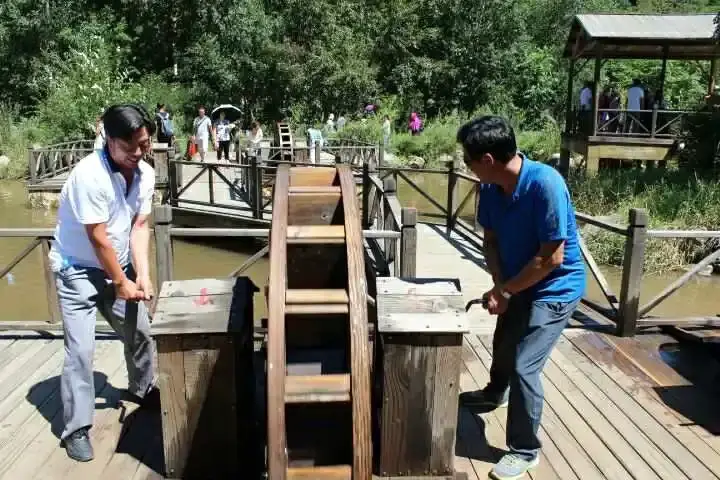
pedal water wheel:
In contrast, foot-operated “pedal carts” had significantly higher production efficiency and irrigation results compared to hand-turned wheels. The working principle of the pedal cart was similar to the hand-turned wheel, but it involved using a foot pedal, a movable wooden board on the cart, to drive the crankshaft and chain, thereby lifting water to higher areas.
When using a pedal cart, typically two to three people formed a group, and a supporting board was provided at waist level for leaning on, reducing fatigue and saving energy. Clever Chinese farmers even added a sunshade on top of the pedal cart, allowing them to avoid direct sunlight during water lifting and significantly improving the working environment. We can still see scenes of farmers using this foot-operated wheel to resist drought in some films. The farmers could chat while working, and the comfort level was incomparable to hand-turned wheels. The pedal cart had a larger size, and with the collective efforts of farmers, each person could irrigate eight to ten mu of farmland (approximately 0.53-0.67 hectares) per day, greatly improving labor efficiency.
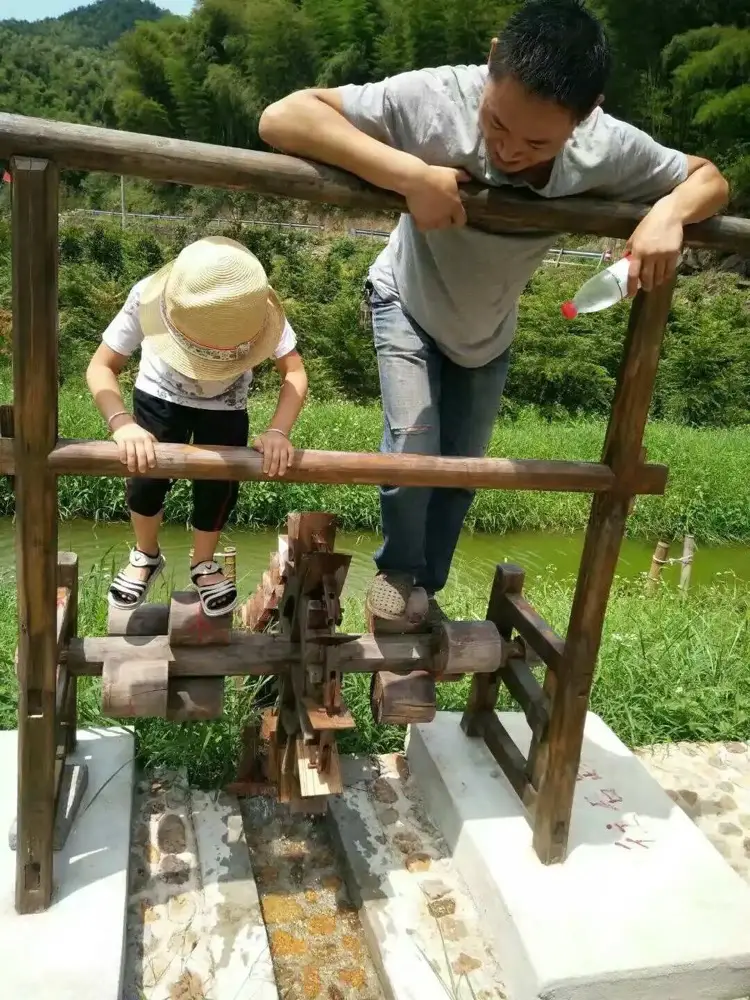
Animal-powered water wheel:
If conditions permitted, livestock could also be used to power the water wheel. With slight modifications to the foot-operated design, the water wheel could be driven by draft animals. The specific approach involved using animals to pull a horizontal wheel, which, in turn, drove a vertical wheel. The vertical wheel, in conjunction with the chain, facilitated water lifting. The horizontal wheel was often detachable, allowing it to be attached when animals were available and removed for manual operation when animals were unavailable, providing great convenience.
Animal-powered water wheels had much higher efficiency than human-powered ones. According to records in the “Nóngshū,” a water wheel pulled by oxen could replace the work of three human-operated pedal carts, making it more suitable for irrigating large plain areas.
The wisdom of the Chinese people is boundless. In the process of production practice, they also invented water wheels that utilized water or wind energy for water lifting. These types of water wheels harnessed the power of water flow or wind to drive the axle and lift water. However, these two types of water wheels had higher environmental requirements during usage. If there were no significant water flow differences or wind availability nearby, they would be rendered ineffective. Therefore, these two types of water wheels served as supplementary methods and were not commonly used for ancient agricultural irrigation.
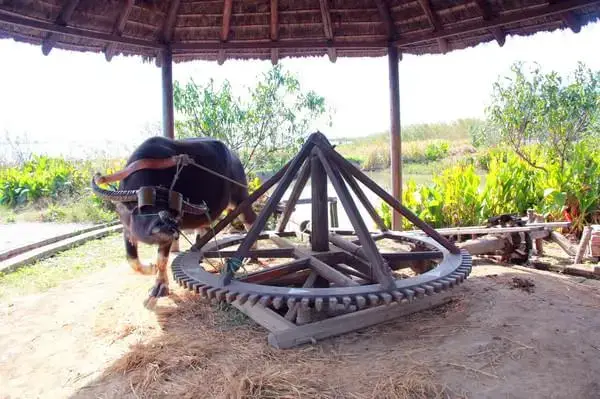
Tongche:
Apart from the waterwheel, there is another type of waterwheel fixed on the banks of rivers, known as the “tongche” or “barrel wheel.” Its main difference from the waterwheel is that it is non-removable and fixed on the riverbank. It continuously operates day and night, harnessing the force of flowing water. The purpose of the “tongche” is to continuously draw water from the river and channel it into elevated ditches, which then flow into fields, fulfilling the irrigation tasks.
The main feature of the “tongche” is its ability to vertically lift water to higher locations, making it particularly suitable for steep riverbanks. During its construction and installation, a large wheel is first built to match the height of the riverbank. The wheel must be higher than the riverbank. Bamboo tubes are then attached to the wheel, and a water channel is created not far upstream. The rushing water from the channel impacts the rotating blades on the wheel, causing it to spin continuously. As the wheel turns, the bamboo tubes dip into the river one by one, filling with water. With the rotation of the wheel, the water from the tubes is poured into the ditches, accomplishing the purpose of water diversion and irrigation.
During the construction and installation of the “tongche,” it is important to ensure that the bottom of the wheel remains immersed in the water to a certain depth. It is also preferable to set it up in turbulent sections of the river. This allows for a stronger impact from the water flow, resulting in faster wheel rotation and a greater amount of water being drawn. Additionally, when attaching the bamboo tubes, they should be angled in a way that ensures the water inside the tubes can be completely emptied as the wheel rotates to a certain angle. These practices are based on the practical experience of ancient farmers and contain simple scientific principles.
Longgusui Che
The “Longgusui Che” (Dragon Backbone Water Wheel), also known as “Fan Che,” “Ta Che,” or simply “Longgusui,” is an irrigation tool in the history of the Han ethnic group and is prevalent in most parts of China. This water-lifting device has a long history and is named “Longgusui” because its shape resembles a dragon’s backbone.
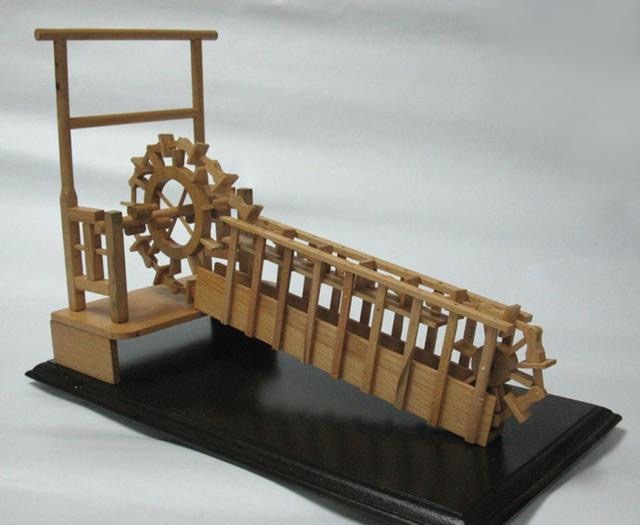
Windmill:
Records of factory windmills appeared in the Ming and Qing dynasties. A windmill consists of two parts: the windmill itself and the water wheel. The windmill transfers wind energy to the water wheel, which, in turn, transfers the energy to the water being lifted, allowing for water elevation. This type of pumping mechanism is used for drainage in the Taihu Lake basin and can operate whenever there is wind.
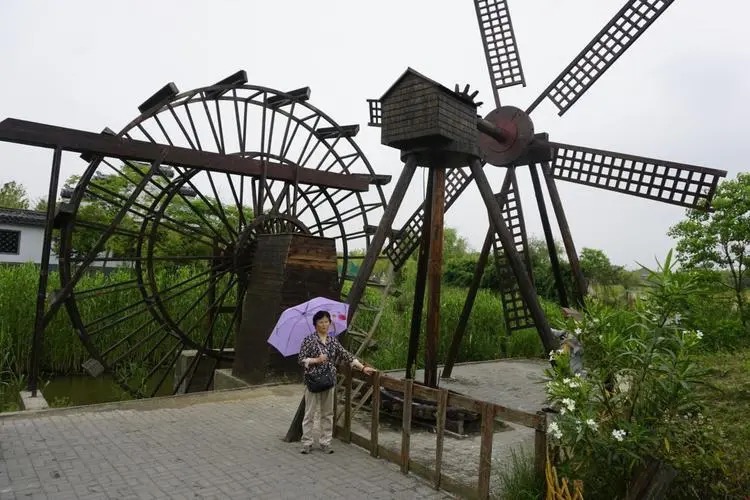
what is water wheel irrigation?
Waterwheel irrigation in farmland operates on the principle of utilizing the natural flow of river water to generate propulsion. When the water current impinges on the wheel blades, it drives the rotation of the waterwheel. The water buckets attached to the wheel fill with river water and are elevated to a height of approximately 20 meters. When reaching the top, the water buckets naturally tilt, releasing the water into a trough, from where it flows into the fields requiring irrigation.
I. How does waterwheel irrigation work?
Waterwheel irrigation achieves irrigation by directing the water source into a trough. The specific process is as follows:
- The waterwheel typically consists of a central axle, around 0.5 meters in diameter and 5 meters in length, supporting 24 wooden spokes radiating outwards. Each spoke has a water bucket and a scraper at its top end. The water bucket is used to hold water, while the scraper is used to guide the water.
- As the river water flows, the waterwheel slowly rotates, allowing the water buckets to scoop up the river water. The water is then lifted to a height of around 20 meters. When the buckets reach the top, they naturally tilt, releasing the water into the trough, which subsequently flows into the fields requiring irrigation.
- A typical waterwheel weighs around 10 tons and has a height of approximately 10 meters. Its appearance resembles that of ancient cartwheels.
II. The role of waterwheels:
- Waterwheels, also known as “tianche” or “heavenly cart,” are ancient tools for water lifting and irrigation.
- Some larger waterwheels can have a diameter of about 20 meters and lift water to heights of 15-18 meters. Large-scale waterwheels can irrigate 600-700 mu of farmland, while smaller ones can irrigate 100-200 mu of farmland.
- Waterwheel irrigation achieves labor, energy, and cost savings, making it an advanced irrigation tool in ancient times.
- Waterwheels are an important part of Chinese agricultural culture, embodying the creativity of the Chinese nation and witnessing the agricultural civilization of China. They also provide valuable evidence for the history of water management research.
- The invention of waterwheels laid the foundation for the well-being and stability of ancient communities. It contributed to the harmonious and prosperous society of the time.
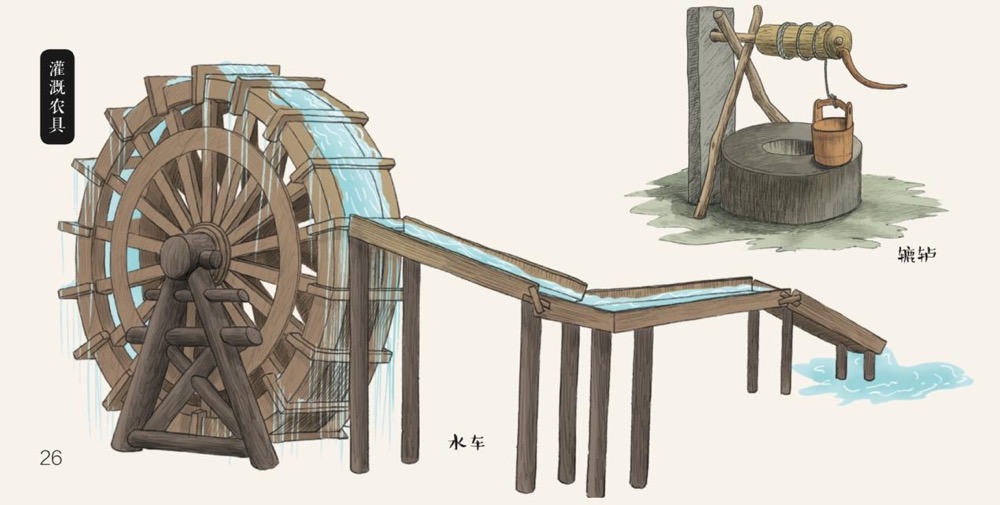
Chinese water wheels history
Stages of Development of Waterwheels:
First Stage:
The earliest recorded waterwheel in China is believed to have emerged during the Eastern Han Dynasty, around the reign of Emperor Ling. It was called the “fanche” and featured basic components such as a wheel axle and paddles. There is also mention of the “fanche” being manufactured by a person named Ma Jun during the Three Kingdoms period. Whether the invention of the waterwheel can be attributed to a specific individual is uncertain, but the formal introduction of the waterwheel in China during the Eastern Han Dynasty to the Three Kingdoms period marked the emergence of this ancient agricultural irrigation tool. It was also known as the “Kongmingche” and represents China’s oldest agricultural irrigation tool. The waterwheel was a remarkable technological achievement created by our ancestors during their quest for societal progress. It stands as a precious cultural heritage. According to legend, a prototype was developed during the reign of Emperor Ling, and it was further improved and widely utilized in the Shu Kingdom during the Three Kingdoms period. This can be regarded as the first stage of the establishment of waterwheels in China.
Second Stage:
The development of waterwheels progressed significantly during the Tang and Song dynasties, particularly in the application of wheel axles. A type of waterwheel called the “tongche” or “barrel wheel” was introduced. It featured the use of water power and incorporated water reservoirs and connected barrels, enabling water to be lifted from lower to higher levels. This advancement not only increased the effectiveness of waterwheels but also saved valuable human labor. Waterwheels played a significant role in agricultural activities. This represents the second stage of the development of waterwheels in China.
Third Stage:
During the Yuan and Ming dynasties, further advancements were made in wheel axle technology. Waterwheels were equipped not only with one set of gears but multiple sets. This led to the emergence of different types of waterwheels, such as those powered by water, cattle, or donkeys. They could be adapted to local conditions and terrain. This development greatly improved the efficiency and utility of waterwheels. Since their invention during the Eastern Han and Three Kingdoms periods, waterwheels had relied solely on human power. However, with the utilization of hydraulic and animal power, human labor was finally liberated from operating the waterwheel’s pedals. Additionally, the development of rotating axles, vertical wheels, and horizontal wheels allowed the original water-powered “tongche” to make contributions even in areas with less abundant water resources by utilizing animal power. Furthermore, the emergence of “high-turning barrel wheels” enabled water to be lifted to higher levels in steep and inaccessible terrain where constructing water reservoirs was not feasible. This represents the third stage of the development of waterwheels in China. After the Yuan and Ming dynasties, there were no significant achievements in the development of waterwheels in China.
From the above discussion, it is evident that waterwheels have made significant contributions to the development of agriculture in China. They alleviated the constraints imposed by topography, enabling the cultivation of hilly and sloping lands. Waterwheels were not only used for water extraction during dry periods but also for drainage during periods of excessive water accumulation.
who invented Chinese water wheels?
The Chinese water wheel was invented by? The inventor of the “fanche” (waterwheel) is Bi Lan, according to historical records. Researchers have found that the basic structure of the “fanche” invented by Bi Lan is still widely used in some rural areas today, with minimal changes.
The “Nongshu” (Book of Agriculture) records that Bi Lan not only invented the “fanche” but also created many other agricultural tools, such as copper figures, giant bells, Tianlu (a type of musical instrument), and shrimp tombs. However, Bi Lan’s identity as a eunuch has led some history enthusiasts to believe that these agricultural tools were not solely his inventions.
From a realistic perspective, these agricultural tools were most likely the collective result of the efforts of the people during the Han Dynasty. However, it is a common practice in Chinese historiography to attribute collective inventions to a single inventor, similar to the case of Cai Lun and the invention of papermaking. As a eunuch, it is highly unlikely that Bi Lan personally engaged in inventing and creating. It is more plausible that he was assigned by the emperor to oversee and supervise manufacturing-related tasks.
The “fanche” manufactured by Bi Lan was highly practical and could efficiently transport large amounts of water, providing significant convenience for farmers. Its utility 1,800 years ago is beyond our imagination. However, according to historical records, initially, the “fanche” invented by Bi Lan was not immediately used in agricultural production. It was primarily employed for watering roads in the southern and northern suburbs to save the expense of manual watering. It was only later that someone recognized its agricultural value and introduced it to farmland, turning it into an agricultural tool.
It is well known that the emperors Huan and Ling of the Han Dynasty were notorious for their incompetence, with eunuchs and relatives-in-law overshadowing their reigns, leading to the rise of power-holding ministers and widespread corruption within the court. Due to the foolishness of the emperors, internal conflicts in the country escalated, eventually sparking the Yellow Turban Rebellion. Although the “fanche” invented by Bi Lan was sparingly used in agriculture, for the most part, it served as a recreational tool in the palace. Therefore, while Bi Lan is credited as the inventor of the “fanche,” he was not the pioneer who introduced it for practical agricultural use. The societal productivity improvements brought about by Bi Lan were quite limited.
The situation changed with the inventor Ma Jun during the Three Kingdoms period. After Cao Cao unified the north and put an end to the war, the people living there finally experienced peace and stability. Against the backdrop of rebuilding the nation, there was a growing demand for scientific and technological advancements, particularly in agricultural techniques.
During this period, the “fanche” had already been sparsely used in agriculture. Ma Jun made improvements to this agricultural tool (as the previous “fanche” primarily served palace watering purposes and had insufficient water intake). While ensuring the lightweight nature of the “fanche,” Ma Jun increased its water intake capacity and simplified its structure. The “fanche” produced by Ma Jun possessed the advantage of “four ounces moving a thousand pounds,” making it effortless to operate even for children without much strength, allowing them to easily fetch water.
Furthermore, Ma Jun’s “fanche” had elements of “automation” as it could automatically fetch water using hydraulic power without the need for manual supervision. Due to the convenience of Ma Jun’s inventions, the “fanche” quickly gained popularity nationwide and became a commonly used agricultural tool in households.
The inventors and improvers of the “fanche,” Bi Lan and Ma Jun, hold vastly different historical positions. While Bi Lan is mentioned in historical records, his identity as a eunuch resulted in later generations viewing him unfavorably, leading to a relatively low historical evaluation. On the other hand, Ma Jun, who came from a humble background, earned a favorable reputation in later generations. However, during the Three Kingdoms era, Ma Jun, as an inventor without significant social status, was also not highly regarded.
There are also claims that Zhuge Liang, during his time in the Shu Kingdom, improved and promoted the “fanche,” contributing to the widespread adoption of waterwheel technology.
As modern individuals, it is sufficient for us to recognize the inventions and creations left behind by Bi Lan and Ma Jun. Both of them are great inventors.
Due to its reasonable and reliable structure and practicality, this type of waterwheel has been passed down through generations. It quietly exited the historical stage only in recent times with the widespread use of agricultural water pumps.
when was the water wheel invented in ancient China?
Before the appearance of waterwheels, the laboring people of China invented a water-lifting tool called “júgāo” for field irrigation. This primitive water-lifting tool has been widely used in agricultural irrigation since the Shang Dynasty. It consists of an upright frame with a long lever attached, serving as the fulcrum, with a weight suspended at the end and a bucket hanging at the front. By raising and lowering the lever, water can be lifted with ease. When the bucket is placed in water and filled, the force of gravity at the end of the lever allows the water to be easily lifted to the desired location.
According to the record in the book “Shuō Yuàn: Fǎn Zhì” (Discourses Analyzed: Countering Arguments), during the Spring and Autumn Period, when the statesman Dèng Xī passed through the state of Wèi, he saw several farmers “carrying pots and entering the well, irrigating the leeks all day in one area.” These farmers in Wèi State were still using clay jars to fetch water and pour it into the fields for irrigation, which was time-consuming, labor-intensive, and inefficient. Seeing this, Dèng Xī felt sympathetic and taught the farmers of Wèi State the irrigation method used by the farmers in the state of Zheng. The specific method was described as “create a lever, heavier at the back and lighter at the front, and call it a ‘bridge.’ Irrigate the leeks tirelessly in a hundred areas all day long.” The irrigation tool taught by Dèng Xī was the “júgāo.”
The book “Zhuāngzi” also records that during a journey to Hànyín, Zǐ Gòng, a disciple of Confucius, saw farmers carrying jars to fetch water, which required twice the effort for half the result. So, he taught them to “carve wood to create a lever, heavier at the back and lighter at the front, pulling water as if drawing broth, swiftly and effortlessly.” This indicates that primitive irrigation tools were already in use during the Spring and Autumn Period and served as the prototype for later waterwheels. The júgāo was quite common as early as the Spring and Autumn Period and continued to be used for thousands of years as an old-fashioned water-lifting tool in rural areas of China. Although this simple water-lifting tool was basic, it significantly reduced the labor intensity for the working people.
Principle of the júgāo:
The structure of the júgāo is equivalent to a standard lever. It consists of a horizontal long bar supported or suspended in the middle by a vertical wooden beam. One end of the horizontal bar is connected to the water-lifting device using a straight rod, while the other end is tied or suspended with a heavy stone. When not lifting water, the position of the stone is lower (with less potential energy). When water needs to be lifted, a person exerts force by pressing down on the straight rod and the water-lifting device. At the same time, the position of the stone at the other end rises (increasing potential energy). Once the water-lifting device is filled, the stone at the other end is allowed to descend, converting the stored potential energy of the stone. Through the action of the lever, the water-lifting device can be raised. In this way, the main direction of force during the water-lifting process is downwards. Since downward force can leverage a person’s body weight, it gives the feeling of being effortless and significantly reduces the fatigue of lifting water for individuals. This water-lifting tool was a primary irrigation machine in ancient Chinese society.
The júgāo, a simple machine used for water-lifting or irrigation in ancient China, is constructed based on the principle of a lever. It can change the direction of force, making it easier to lift the water bucket. Early records of the júgāo can be found in the book “Zhuangzi,” specifically in Chapter Five “Tian Yun Pian” (The Pivot of Heaven) during a conversation between Yǎn Yuān (521-490 BCE) and Shī Jīn: “And haven’t you seen the júgāo? Pull it, and it bends down; let it go, and it rises up.”
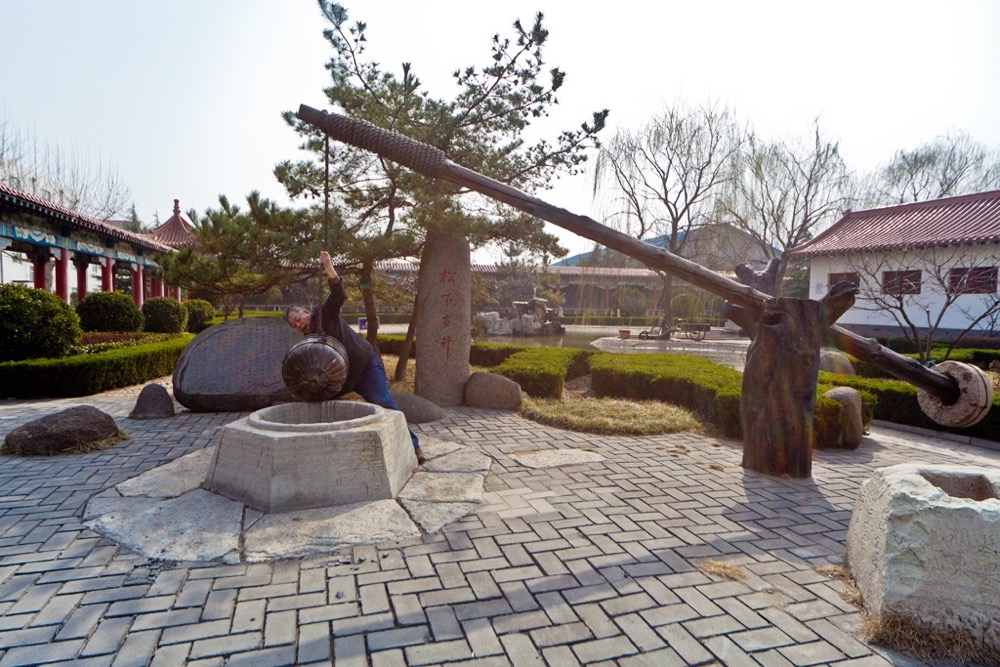
where was the water wheel invented?
With the development of productivity and advancements in science and technology, by the end of the Eastern Han Dynasty, a significant irrigation tool called the water wheel emerged.
The water wheel, also known as fānchē (翻车) in Chinese, was named the “dragon bone water wheel” due to its structure resembling dragon bones. The invention and use of the dragon bone water wheel in China have a history of over 1,700 years. According to the biographies of eunuchs and Zhang Rang in the book “Book of the Later Han” (Hòu Hàn Shū), during the third year of the Zhongping era of Emperor Ling of Han (186 CE), the capital city of Luoyang experienced drought, and the roads were covered in dust. Prime Minister Zhang Rang ordered the eunuch Bì Lán to design a water wheel to address the water shortage in the capital city, alleviate the hardship of watering the roads for the common people, and save expenses. At that time, the design of the water wheel was intended for watering the roads and had not been applied to agricultural production. During the Three Kingdoms period, a skilled craftsman named Mǎ Jūn resided in Luoyang under the Wei Kingdom. He noticed a vegetable garden in the capital city that was unable to be irrigated, leading to barrenness. In response, he studied and reformed the previous water wheel design, creating a fānchē that could be used for agricultural irrigation. “(Mǎ Jūn) resided in the capital city where there was land suitable for gardening, but there was a lack of water for irrigation. He then constructed a fānchē and had children rotate it to irrigate the land. The water self-subsided, flowing in and out effortlessly, and its ingenuity was a hundredfold greater than usual.”
how does a water wheel work?
The structure of a water wheel typically includes the water wheel itself, a frame or support structure, a driving system, and a water discharge system. The water wheel is usually made of wood or iron and is mounted on a frame or support structure. Through a transmission mechanism, the water wheel transfers energy to the driving system, enabling the transfer of water.
The principle of the water wheel is not complex, but considering the historical context, it is truly impressive and ingenious. Ancient water wheels were also referred to as “dragon bone water wheels.” This name is related to ancient Chinese legends where people believed that the Dragon King presided over rivers, lakes, and seas. The name “dragon bone water wheel” embodies the vision that this agricultural tool can better utilize water to ensure bountiful harvests. Furthermore, the name is also related to the structure of the water wheel itself. The central part of the wheel consists of a long trough, and vertical wooden blades, called “board leaves,” are placed inside the trough to “scoop” water. These board leaves are connected section by section using wooden tenons, forming a long chain-like structure similar to a bicycle chain. From a distance, it resembles the skeleton of a dragon. At one end of the wheel, a small gear is installed underwater, while a large gear is mounted on the shore. The center of the large gear has an axle attached to the water wheel. At the top of the axle, there are two rods, also known as handles, which serve as the pedals of the water wheel, similar to a bicycle. A person leans against the crossbar of the frame, steps on the handles, and as the large gear rotates, driven by the small gear, water is continuously “scooped” onto the shore.
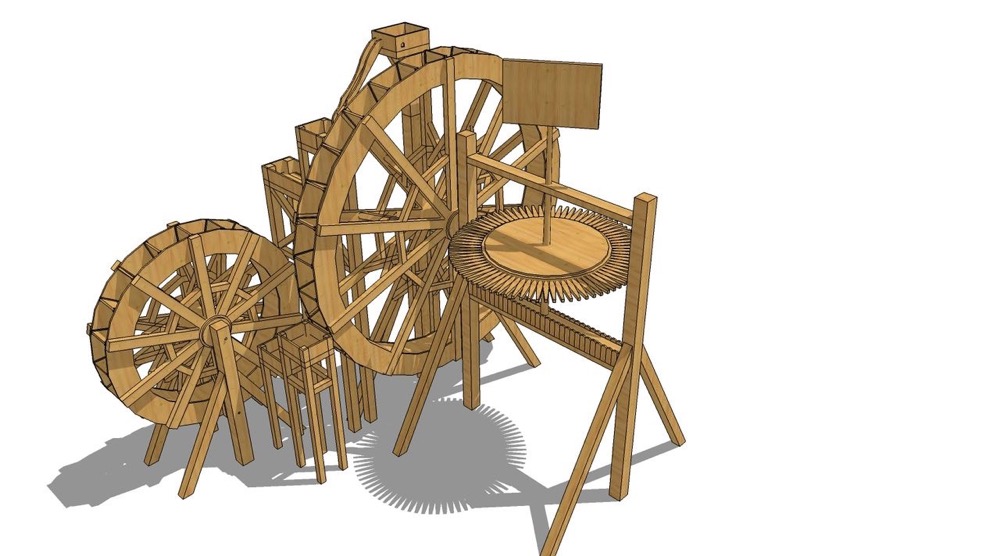
water wheels symbolism in China
The water wheel is a production tool for irrigating rice. It symbolizes the continuous efforts of the laboring people towards a better life and embodies the spirit of fortune turning with time.
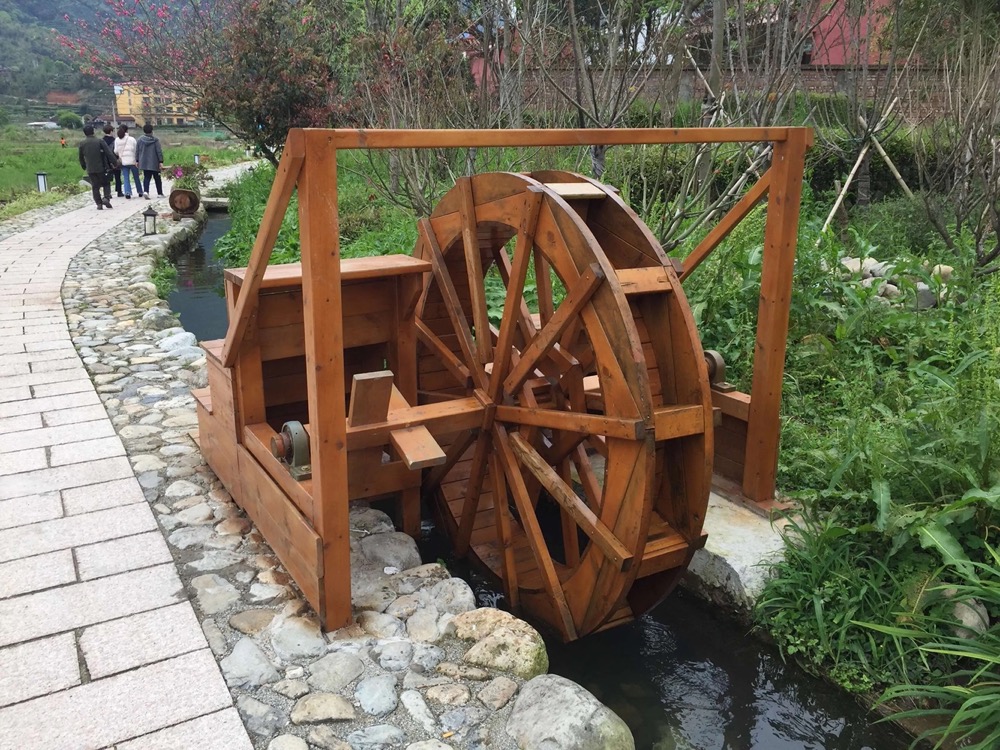
water wheels in feng shui
What is the role of a water wheel in feng shui?
The water wheel in feng shui is typically associated with either a rotating wheel with water or a rotating sphere with water, or both. The water needs to be flowing in order to create the effect of a spinning water wheel or sphere. It is believed that “mountains control human relationships, while water controls wealth.” The continuous circulation of water in the water wheel or sphere represents the concept of abundant and unending flow, creating the optimal effect for enhancing wealth and facilitating auspicious energy.
Where is the best position to place a water wheel in a store?
According to feng shui, it is ideal to place the water wheel near the entrance or close to the front of the store. This positioning symbolizes prosperous wealth, good connections, and smooth flow of energy.
Can a fish tank and a flowing water wheel be placed together in home feng shui?
If you are referring to a fish tank as a “feng shui fish,” then it is possible to place them together. However, it is important that you cannot hear the sound of water. If you have both a fish tank and a flowing water wheel in the same location, it is not suitable. Having these two elements in separate locations would be considered a major feng shui taboo, similar to outdoor feng shui. For example, having two fish ponds in front of the entrance would form the shape of the Chinese character “kū” (哭), which is considered inauspicious.
Chinese water wheels vs European water wheels
Chinese Water Wheels:
Chinese water wheels, also known as “dragon bone water wheels” due to their resemblance to dragon bones, have a long history dating back over 1,700 years. They were primarily used for irrigation purposes in agriculture. Chinese water wheels typically feature a long trough-like structure with wooden blades arranged vertically inside. These blades are connected by wooden joints, forming a chain-like structure. The water wheel harnesses the energy of flowing water to transfer it to a driving mechanism, enabling the movement of water for irrigation.
European Water Wheels:
European water wheels, also known as undershot water wheels, were widely used in Europe during the Middle Ages and the Renaissance. They were commonly employed for various purposes, including milling grain, powering machinery, and pumping water. European water wheels are characterized by their placement at the bottom of a flowing stream or river. The force of the water flowing against the blades of the wheel causes it to rotate, which in turn drives a central shaft connected to the machinery or equipment.
Comparison:
While both Chinese and European water wheels utilize the power of water for different applications, there are notable differences between them. Chinese water wheels tend to have a chain-like structure with vertically arranged blades, while European water wheels typically have paddle-like blades arranged horizontally. Chinese water wheels were primarily used for irrigation in agriculture, whereas European water wheels were utilized for milling and various industrial purposes. Additionally, the design and construction techniques of the two types of water wheels differ due to regional variations and historical contexts.
Overall, Chinese and European water wheels represent distinct engineering achievements in harnessing water power and played significant roles in their respective cultures and historical periods.
Chinese water wheels vs Roman waterwheel
Chinese Water Wheels:
Chinese water wheels, also known as dragon bone water wheels, have a long history in China and were primarily used for irrigation purposes in agriculture. They consist of a long trough-like structure with vertically arranged wooden blades connected by joints. The water wheel harnesses the energy of flowing water to transfer it to a driving mechanism, enabling the movement of water for irrigation.
Roman Waterwheel:
Roman waterwheels, also known as Roman norias or “mills of the Augurs,” were used in ancient Rome for various purposes, including irrigation, milling grain, and powering machinery. The design of Roman waterwheels typically involved a large wooden wheel with buckets or pots attached to its rim. As the wheel turned, the buckets would dip into a water source and carry the water upwards, pouring it into an aqueduct or trough for irrigation or other uses.
Comparison:
Chinese water wheels and Roman waterwheels share the common purpose of utilizing water power, but they have distinct design and operational differences. Chinese water wheels feature vertical blades connected in a chain-like structure, while Roman waterwheels use buckets or pots attached to a rotating wheel. Chinese water wheels were primarily used for irrigation, while Roman waterwheels served multiple purposes, including irrigation, milling, and power generation.
Another notable difference is the orientation of the water wheels. Chinese water wheels are typically horizontal, with the water flowing against the blades, while Roman waterwheels are generally vertical, with the water being scooped up by the buckets or pots.
Additionally, Chinese water wheels have a longer historical timeline, dating back over 1,700 years, while Roman waterwheels were prominent during the Roman Empire period.
Overall, both Chinese water wheels and Roman waterwheels represent significant engineering achievements in harnessing water power and played important roles in their respective cultures and historical periods.
Chinese water wheels vs Greek water wheel
Chinese Water Wheels:
Chinese water wheels, also known as dragon bone water wheels, were widely used in ancient China for irrigation purposes. They feature a horizontal axis and consist of a series of wooden blades connected in a chain-like structure. The water flowing against the blades provides rotational energy, which is harnessed to power various applications, such as lifting water for irrigation.
Greek Water Wheel:
Greek water wheels, also referred to as “sakia” or “noria,” were used in ancient Greece for tasks like irrigation and water lifting. The design of Greek water wheels typically involved a vertical axis with wooden or metal buckets attached to a wheel. As the wheel rotated, the buckets would dip into a water source and then pour the water into a trough or aqueduct for irrigation or other purposes.
Comparison:
Chinese water wheels and Greek water wheels have some similarities but also notable differences. Both systems utilize the power of flowing water for irrigation and water lifting, but they differ in their axis orientation and blade/bucket arrangement.
Chinese water wheels have a horizontal axis, while Greek water wheels have a vertical axis. The horizontal design of Chinese water wheels allows the water to flow against the blades, generating rotational energy. In contrast, Greek water wheels have vertically positioned buckets that scoop up water as the wheel rotates.
Furthermore, Chinese water wheels typically feature a chain-like structure with interconnected blades, while Greek water wheels have separate buckets attached to the wheel’s rim.
The historical contexts of these water wheel systems also differ. Chinese water wheels have a longer history, dating back over 1,700 years, while Greek water wheels were used during the ancient Greek period.
In summary, Chinese water wheels and Greek water wheels share the common purpose of harnessing water power for irrigation and lifting water. However, they differ in design, axis orientation, and blade/bucket arrangement, reflecting the specific engineering approaches and cultural contexts of ancient China and Greece.
Chinese water wheels vs windmill
Chinese Water Wheels:
Chinese water wheels, as mentioned before, were used for irrigation purposes in ancient China. They typically had a horizontal axis with interconnected wooden blades. The rotational energy generated by the flowing water was utilized for lifting water or powering other machinery.
Windmills:
Windmills, on the other hand, are devices that convert the energy of wind into rotational energy. They consist of a tall structure with blades or sails attached to a horizontal axis. As the wind blows, it causes the blades to rotate, and this rotational motion can be harnessed for various applications such as grinding grain, pumping water, or generating electricity.
Comparison:
Chinese water wheels and windmills are both mechanical devices that harness natural forces for useful work. However, they differ in terms of the source of energy they utilize.
Chinese water wheels rely on the force of flowing water, typically from a river or stream, to generate rotational energy. They are primarily used for irrigation purposes, lifting water for agricultural needs.
Windmills, on the other hand, utilize the kinetic energy of wind. They are designed to capture the wind’s power using their large blades or sails, which rotate when wind blows against them. Windmills have a broader range of applications, including grinding grain, pumping water, and generating electricity.
In terms of construction and design, Chinese water wheels have a horizontal axis and interconnected blades, while windmills have a vertical structure with blades or sails attached to a horizontal axis.
Both Chinese water wheels and windmills have played significant roles in ancient civilizations and have contributed to the development of agricultural practices and industries. They represent ingenious engineering solutions for harnessing natural energies to meet human needs.
Chinese water wheels vs gear
Chinese Water Wheels:
Chinese water wheels, as discussed earlier, are mechanical devices used for irrigation purposes. They harness the energy of flowing water to generate rotational motion. They typically have a horizontal axis with interconnected wooden blades or buckets. The rotational energy can be used directly for lifting water or transferred to other machinery through transmission systems.
Gears:
Gears, on the other hand, are mechanical components with toothed wheels that interlock to transmit rotational motion and torque between two or more shafts. They are widely used in various machines and mechanisms to control speed, direction, and force transmission. Gears come in different types, including spur gears, helical gears, bevel gears, and worm gears.
Comparison:
Chinese water wheels and gears serve different purposes and operate on different principles.
Chinese water wheels primarily harness the energy of flowing water to generate rotational motion for irrigation and other water-related applications. They utilize the force of the water to directly rotate the wheel or transfer the energy to other machinery without the use of gears.
Gears, on the other hand, are used to transmit and control rotational motion and torque in various mechanical systems. They allow for speed reduction or increase, direction change, and torque amplification. Gears are typically employed in machines where precise control and transmission of rotational motion are required.
While Chinese water wheels and gears are both mechanical components, they serve distinct functions and operate on different principles. Chinese water wheels utilize the force of water for rotational motion, whereas gears are used for transmitting and controlling rotational motion in various mechanical systems.
Chinese water wheels vs wheel
Chinese Water Wheels:
Chinese water wheels are large mechanical devices used for harnessing the energy of flowing water to perform various tasks, such as irrigation, grinding grains, and powering machinery. They typically consist of a large horizontal wheel with interconnected blades or buckets. As the wheel rotates due to the force of flowing water, it can lift water or transfer its rotational energy to other mechanisms.
Wheels:
Wheels, on the other hand, are circular objects that rotate around an axle. They are one of the most important inventions in human history and have numerous applications, including transportation, power generation, and mechanical systems. Wheels are commonly made of materials like wood, metal, or rubber and can vary in size and design depending on their intended use.
Comparison:
Chinese water wheels and wheels serve different purposes and have different mechanisms of operation.
Chinese water wheels are specialized machines designed specifically to harness the energy of flowing water. They are typically larger and more complex than simple wheels, as they are optimized for specific tasks like water lifting and mechanical power generation.
Wheels, in general, are more versatile and have a wide range of applications. They can be used in various contexts, such as vehicles, machinery, and equipment. Unlike Chinese water wheels, traditional wheels do not rely on the force of flowing water for their operation. Instead, they are driven by external forces like manual or mechanical input.
In summary, Chinese water wheels are a specific type of wheel designed for harnessing water energy, while wheels in general have broader applications and can be powered by various means.
Chinese water wheels vs Ferris wheel
Chinese Water Wheels:
Chinese water wheels are large mechanical devices used for harnessing the energy of flowing water to perform tasks such as irrigation or powering machinery. They consist of a horizontal wheel with interconnected blades or buckets that rotate due to the force of flowing water. Chinese water wheels were historically used for practical purposes rather than entertainment.
Ferris Wheel:
A Ferris wheel is a large amusement ride consisting of a rotating upright wheel with passenger cabins attached to the rim. It is primarily designed for entertainment purposes and offers riders a panoramic view from an elevated position. Ferris wheels are commonly found in amusement parks and are a popular attraction worldwide.
Comparison:
Chinese water wheels and Ferris wheels serve different purposes and have distinct features:
Purpose: Chinese water wheels were designed for practical applications, such as irrigation and mechanical power generation. They were used to harness the energy of flowing water for essential tasks. On the other hand, Ferris wheels are recreational attractions created for entertainment and providing riders with a unique vantage point and experience.
Mechanism: Chinese water wheels rely on the force of flowing water to rotate the wheel and generate power or lift water. Ferris wheels, on the other hand, are powered by motors or engines that drive the rotation of the wheel. The motion of a Ferris wheel is controlled and deliberate, whereas Chinese water wheels are driven by the natural flow of water.
Design: Chinese water wheels are typically larger and more complex, featuring interconnected blades or buckets to efficiently capture the energy of water. In contrast, Ferris wheels have a symmetrical design with passenger cabins attached to the rim. The cabins on a Ferris wheel are specifically designed for comfort and safety, providing a pleasant experience for riders.
In summary, Chinese water wheels and Ferris wheels differ in their purpose, mechanism, and design. Chinese water wheels are functional devices used for harnessing water energy, while Ferris wheels are recreational rides intended for entertainment and offering panoramic views.
water wheel dream meaning
Dreaming of a water wheel turning clockwise:
Symbolizes that the dreamer’s career will progress smoothly and achieve success.
Dreaming of a water wheel turning counterclockwise:
Serves as a reminder that the dreamer may face setbacks and challenges in their career. It suggests being prepared to overcome obstacles and face them with a positive attitude.
Dreaming of a stationary water wheel:
Implies that the dreamer’s career and life are stable, without significant ups and downs. This dream represents a normal and steady state.
Dreaming of a malfunctioning water wheel:
Warns the dreamer of a downturn in their career, experiencing setbacks and significant damage. It may be challenging to continue operating normally. The dream encourages you to overcome the difficulties as soon as possible.
Dreaming of a medium-sized water wheel:
Represents the dreamer’s upcoming comfortable and enjoyable life, experiencing happiness and contentment.
Dreaming of a giant water wheel:
Indicates that the dreamer will achieve significant accomplishments through continuous effort, leading to substantial gains and a significant increase in wealth.
Conclusion
The water wheels of China stand as testament to the country’s rich history, technological prowess, and deep connection with nature. These remarkable inventions, with their ingenious design and practical functionality, played a crucial role in shaping China’s agricultural, industrial, and cultural landscapes. Today, they continue to captivate the imagination of people worldwide, reminding us of the remarkable achievements and ingenuity of ancient Chinese civilization.
